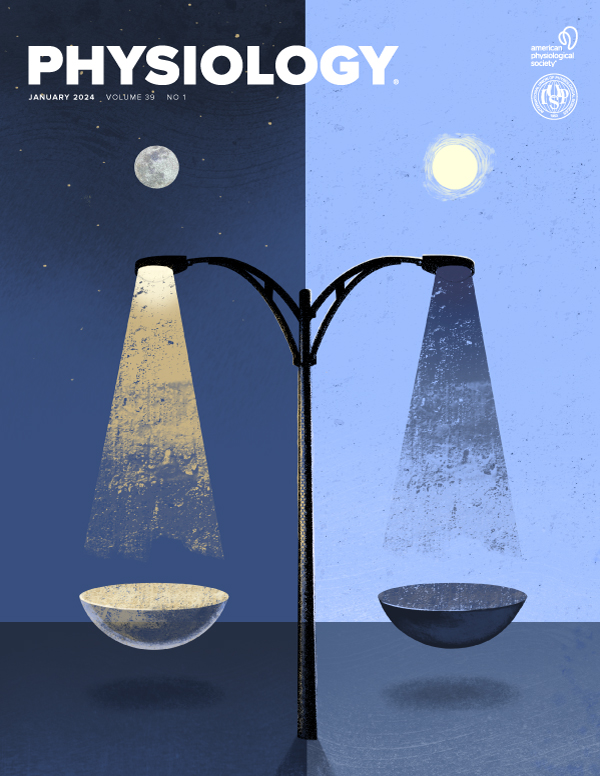Allelic modulation of mesenteric artery mechanical properties in young and adult APOE3 and APOE4 mice
IF 5.3
2区 医学
Q1 PHYSIOLOGY
引用次数: 0
Abstract
Previous studies from our lab have demonstrated age-related changes in vascular structure/function in posterior cerebral arteries (PCA) and left common carotid artery (CA) in male and female mice expressing human-ApoE targeted replacement of APOE3 (B6.129P2-Apoetm2(APOE*3)MaeN8) and APOE4 (B6.129P2-Apoetm3(APOE*4)Mae N8) (Taconic Labs). Therefore, we hypothesized that similar changes may be observed in the peripheral circulation. We isolated 3rd-order mesenteric arteries (MA) from young (Y, 3 to 4 mo) and adult (A, 7 to 10 mo), male and female mice expressing hPOE3 and hAPOE4. Mesenteric artery segments (5-8 mm in length) were isolated and cannulated on an arteriograph to assess vascular mechanical properties (lumen diameter (LD), wall thickness (WT), wall cross-sectional area (CSA), wall:lumen ratio (WL), distensibility (Dist), and stress/strain (SvS) under passive conditions (Ca2+-free Krebs + diltiazem) at intraluminal pressures ranging from 10-140 mmHg. Data were analyzed using two-way ANOVA, Student’s t-test, and analysis of nonlinear fit. Values were considered statistically different at P<0.05. Our data indicate that LD was greater in YE4 compared to YE3 mice (P<0.05), but was smaller in AE4 compared to AE3 mice (P<0.05). WT and WL was greater in YE3 mice compared to YE4 mice (P<0.05), but greater in AE4 compared to AE3 mice (P<0.05). While Dist was similar between YE3 and YE4 mice, AE4 mice exhibited less Dist than AE3 mice (P<0.05). Interestingly, distensibility increased between YE3 and AE3 mice (P<0.05), but was not significantly different between YE4 and AE4 mice. While compliance was similar between YE3 and YE4 mice, and similar between AE3 and AE4 mice, AE4 mice displayed decreased compliance compared to YE4 mice. No difference was seen between YE3 and AE3 mice. Wall stress was greater in YE4 mice compared to YE3 mice, but smaller in AE4 mice compared to AE3 mice (P<0.05), and an analogous pattern was observed in Einc for young and adult mice (P<0.05). These data indicate contrasting patterns of age-related vascular changes between allelotypes. Furthermore, these preliminary findings suggest that MA from A E4 mice exhibit a trend toward a hypertensive phenotype. Support: ABRC/ADHS18-205211 (DME, CBJ), Arizona Alzheimer's Consortium (funded by the Arizona Department of Health Services, Contract No. CTR040636) and matching funds from Midwestern University (DME), Biomedical Sciences Program (JF, KW, JD, DME), Biomedical Sciences Start-up Funds (DME) This is the full abstract presented at the American Physiology Summit 2023 meeting and is only available in HTML format. There are no additional versions or additional content available for this abstract. Physiology was not involved in the peer review process.APOE3和APOE4小鼠肠系膜动脉力学特性的等位基因调控
我们实验室之前的研究表明,在雄性和雌性小鼠中,表达人类APOE靶向替代APOE3 (B6.129P2-Apoetm2(APOE*3)MaeN8)和APOE4 (B6.129P2-Apoetm3(APOE*4)Mae N8)的大脑后动脉(PCA)和左颈总动脉(CA)血管结构/功能的年龄相关变化(Taconic Labs)。因此,我们假设在外周循环中可能观察到类似的变化。我们分离了表达hPOE3和hAPOE4的幼龄(3 ~ 4月龄)和成年(7 ~ 10月龄)雄性和雌性小鼠的第三阶肠系膜动脉(MA)。分离肠系膜动脉段(长度为5- 8mm)并在动脉造影上插管,以评估在10-140 mmHg的腔内压力(无Ca2+ Krebs +地尔硫松)被动条件下(无Ca2+ Krebs +地尔硫松)血管力学特性(管腔直径(LD)、壁厚(WT)、壁横截面积(CSA)、壁:管腔比(WL)、扩张性(Dist)和应力/应变(SvS)。数据分析采用双向方差分析、学生t检验和非线性拟合分析。P<0.05认为差异有统计学意义。我们的数据显示,YE4小鼠的LD高于YE3小鼠(P<0.05),而AE4小鼠的LD低于AE3小鼠(P<0.05)。YE3小鼠WT和WL高于YE4小鼠(P<0.05), AE4小鼠WT和WL高于AE3小鼠(P<0.05)。YE3和YE4小鼠的Dist相似,但AE4小鼠的Dist小于AE3小鼠(P<0.05)。有趣的是,YE3和AE3小鼠的膨胀性显著升高(P<0.05),而YE4和AE4小鼠的膨胀性差异不显著。虽然YE3和YE4小鼠的依从性相似,AE3和AE4小鼠的依从性相似,但与YE4小鼠相比,AE4小鼠的依从性有所降低。YE3和AE3小鼠之间没有差异。YE4小鼠的壁应力比YE3小鼠大(P<0.05), AE4小鼠的壁应力比AE3小鼠小(P<0.05),幼年小鼠和成年小鼠的壁应力与AE3小鼠相似(P<0.05)。这些数据表明了等位基因之间与年龄相关的血管变化的不同模式。此外,这些初步研究结果表明,来自ae4小鼠的MA表现出高血压表型的趋势。支持:ABRC/ADHS18-205211 (DME, CBJ),亚利桑那州阿尔茨海默病联盟(由亚利桑那州卫生服务部资助,合同编号:CTR040636)和来自中西部大学(DME)、生物医学科学计划(JF, KW, JD, DME)、生物医学科学启动基金(DME)的配套资金。这是2023年美国生理学峰会会议上发表的全文摘要,仅以HTML格式提供。此摘要没有附加版本或附加内容。生理学没有参与同行评议过程。
本文章由计算机程序翻译,如有差异,请以英文原文为准。
求助全文
约1分钟内获得全文
求助全文
来源期刊

Physiology
医学-生理学
CiteScore
14.50
自引率
0.00%
发文量
37
期刊介绍:
Physiology journal features meticulously crafted review articles penned by esteemed leaders in their respective fields. These articles undergo rigorous peer review and showcase the forefront of cutting-edge advances across various domains of physiology. Our Editorial Board, comprised of distinguished leaders in the broad spectrum of physiology, convenes annually to deliberate and recommend pioneering topics for review articles, as well as select the most suitable scientists to author these articles. Join us in exploring the forefront of physiological research and innovation.
 求助内容:
求助内容: 应助结果提醒方式:
应助结果提醒方式:


